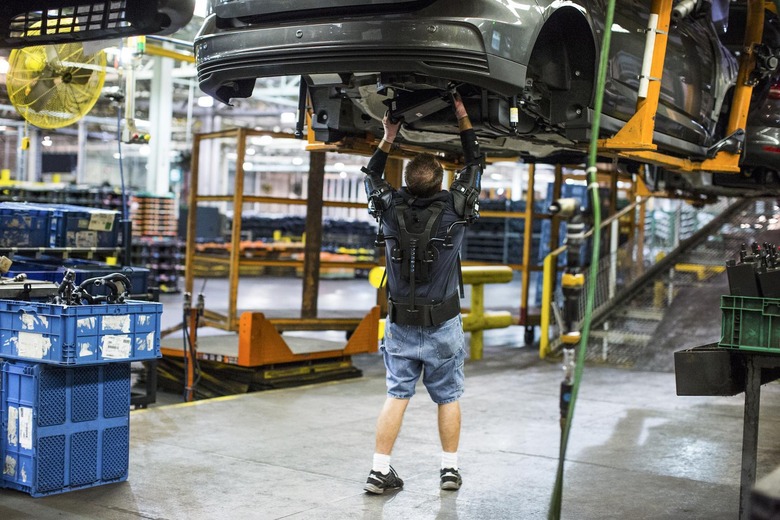Ford Exoskeleton Gives Workers Super-Arms
Once the sole preserve of science-fiction, exoskeletons giving their human operators boosted strength are now increasingly commonplace, with Ford the latest to make use of the high-tech wearables. Dubbed the EksoVest, Ford's new system sadly isn't going to give any of its workers super-human strength or the ability to run faster than the Six Million Dollar Man. Instead, it's intended to support staff with repetitive tasks.
Specifically, tasks which require lots of overhead lifting. Given the nature of car production, while many parts of the process are automated and use robot arms and such, other sections of the build are still completed by hand. Indeed, they involve human workers reaching up above their heads thousands of times each day.

It can have a real impact on physical health. Workers doing such tasks report neck, back, and shoulder pain, as well as fatigue; they're also more likely to injure themselves. In the long-term, there's a greater potential for those problems to become something more serious, and maybe even stop them from working altogether.
The EksoVest is one possible solution being trialled. The collaborative result of Ford working with Ekso Bionics, it's a wearable structure that's strapped like a backpack to the upper body. When in place, it provides between five and fifteen pounds of lift assistance to each arm, cutting the amount of power the worker themselves has to put in, and helping support their muscles. The level of assistance is said to be noticeable, and have an impact either in tool-less tasks or with tools that weigh up to around 8 pounds.

Two US plants are currently testing the EksoVest, and the roadmap includes expanded trials in Europe and South America. It's designed to be worn by people as short as 5 foot tall, to up to 6 feet 4 inches. The degree of lift power added to each arm movement can be adjusted to suit the operator and the task they're working on.
If all goes to plan, it's likely to be rolled out more comprehensively, though not just within the auto industry. Ekso Bionics sees the wearable as being useful in construction sites and distribution centers, where routing lifting and repetitive tasks are commonplace. "The end result is a wearable tool that reduces the strain on a worker's body, reducing the likelihood of injury, and helping them feel better at the end of the day," Russ Angold, co-founder and CTO at the company, says, "increasing both productivity and morale."

MORE Learning to walk with Hyundai's exoskeleton
It's not the only exoskeleton project out there, mind. Hyundai revealed its own takes on the technology back in late 2016, with both a model that could help those with limited leg movement or even paralysis below the waist to walk. Another version, intended like the EksoVest for industrial use, focused on heavy lifting, with a spring-loaded back that could help offset strain on the spine and hips.
Not all exoskeletons are about improving mobility, however. Genworth built a full-body suit that, far from boosting strength and agility, aggressively limits it in an attempt to make young people take aging seriously. The suit is able to hamper arm and leg movement, in addition to affecting vision and hearing, to simulate some of the more common ailments associated with old age.
